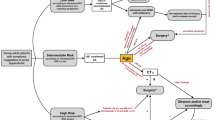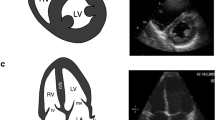Abstract
Background
Management of patients with thoracoabdominal penetrating injuries is challenging. Thoracoabdominal penetrating trauma may harbor hollow viscus injuries in both thoracic and abdominal cavities and occult diaphragmatic lesions. While radiological tests show poor diagnostic performance in these situations, evaluation by laparoscopy is highly sensitive and specific. Furthermore, minimally invasive surgery may avoid unnecessary laparotomies, despite concerns regarding complication and missed injury rates. The objective of the present study is to evaluate the diagnostic and therapeutic performance of laparoscopy in stable patients with thoracoabdominal penetrating injuries.
Methods
Retrospective analysis of hemodynamically stable patients with thoracoabdominal penetrating wounds was managed by laparoscopy. We collected data regarding the profile of the patients, the presence of diaphragmatic injury, perioperative complications, and the conversion rate. Preoperative imaging tests were compared to laparoscopy in terms of diagnostic accuracy.
Results
Thirty-one patients were included, and 26 (84%) were victims of a stab wound. Mean age was 32 years. Ninety-three percent were male. Diaphragmatic lesions were present in 18 patients (58%), and 13 (42%) had associated injuries. There were no missed injuries and no conversions. Radiography and computerized tomography yielded an accuracy of 52% and 75%, respectively.
Conclusion
Laparoscopy is a safe diagnostic and therapeutic procedure in stable patients with thoracoabdominal penetrating wound, with low complication rate, and may avoid unnecessary laparotomies. The poor diagnostic performance of preoperative imaging exams supports routine laparoscopic evaluation of the diaphragm to exclude injuries in these patients.




Similar content being viewed by others
References
Mahajna A, Mitkal S, Bahuth H, Krausz MM (2004) Diagnostic laparoscopy for penetrating injuries in the thoracoabdominal region. Surg Endosc 18(10):1485–1487
Martinez M, Briz JE, Carillo EH (2001) Video thoracoscopy expedites the diagnosis and treatment of penetrating diaphragmatic injuries. Surg Endosc 15(1):28–32
Parreira JG, Rasslan S, Utiyama EM (2008) Controversies in the management of asymptomatic patients sustaining penetrating thoracoabdominal wounds. Clinics. 63(5):695–700
Morales CH, Villegas MI, Angel W, Vásquez JJ (2001) Value of digital exploration for diagnosing injuries to the left side of the diaphragm caused by stab wounds. Arch Surg 136(10):1131–1135
Ivatury RR, Simon RJ, Stahl WM (1993) A critical evaluation of laparoscopy in penetrating abdominal trauma. J Trauma 34(6):822–828
Bodanapally UK, Shanmuganathan K, Mirvis SE, Sliker CW, Fleiter TR, Sarada K et al (2009) MDCT diagnosis of penetrating diaphragm injury. Eur Radiol 19(8):1875–1881
Di Saverio S (2014) Emergency laparoscopy: a new emerging discipline for treating abdominal emergencies attempting to minimize costs and invasiveness and maximize outcomes and patients’ comfort. J Trauma Acute Care Surg. 77(2):338–350
von Elm E, Altman DG, Egger M, Pocock SJ, Gøtzsche PC, Vandenbroucke JP (2014) The strengthening the reporting of observational studies in epidemiology (STROBE) statement: guidelines for reporting observational studies. Int J Surg. 12(12):1495–1499
Baker SP, O’Neill B (1976) The injury severity score: an update. J Trauma 16(11):882–885
Boyd CR, Tolson MA, Copes WS (1987) Evaluating trauma care: the TRISS method. Trauma score and the injury severity score. J Trauma 27(4):370–378
Moore EE, Dunn EEL, Moore JBJ, Thompson JJS (1981) Penetrating abdominal trauma index. J Trauma, pp 439–45
Mentula PJ, Leppäniemi AK (2014) Applicability of the Clavien-Dindo classification to emergency surgical procedures: a retrospective cohort study on 444 consecutive patients. Patient Saf Surg. 8:31
Iochum S, Ludig T, Walter F, Sebbag H, Grosdidier G, Blum AG (2002) Imaging of diaphragmatic injury: a diagnostic challenge? Radiographics 22:103–116
Shackleton KL, Stewart ET, Taylor AJ (1998) Traumatic diaphragmatic injuries: spectrum of radiographic findings. Radiographics 18(1):49–59
Panda A, Kumar A, Gamanagatti S, Patil A, Kumar S, Gupta A (2014) Traumatic diaphragmatic injury: a review of CT signs and the difference between blunt and penetrating injury. Diagn Interv Radiol. 20(2):121–128
Powell BS, Magnotti LJ, Schroeppel TJ, Finnell CW, Savage SA, Fischer PE et al (2008) Diagnostic laparoscopy for the evaluation of occult diaphragmatic injury following penetrating thoracoabdominal trauma. Injury 39:530–534
Friese RS, Coln CE, Gentilello LM (2005) Laparoscopy is sufficient to exclude occult diaphragm injury after penetrating abdominal trauma. J Trauma 58(4):789–792
Rashid F, Chakrabarty MM, Singh R, Iftikhar SY (2009) A review on delayed presentation of diaphragmatic rupture. World J Emerg Surg. 4(1):32
Shah R, Sabanathan S, Mearns AJ, Choudhury AK (1995) Traumatic rupture of diaphragm. Ann Thorac Surg 60(5):1444–1449
Ortega AE, Tang E, Froes ET, Asensio JA, Katkhouda N, Demetriades D (1996) Laparoscopic evaluation of penetrating thoracoabdominal traumatic injuries. Surg Endosc 10(1):19–22
Di Saverio S, Biscardi A, Tugnoli G, Coniglio C, Gordini G, Bendinelli C (2017) The brave challenge of NOM for abdominal GSW trauma and the role of laparoscopy as an alternative to CT scan. Ann Surg 265(4):e37–e38
Clarke DL, Greatorex B, Oosthuizen GV, Muckart DJ (2009) The spectrum of diaphragmatic injury in a busy metropolitan surgical service. Injury 40:932–937
Mihos P, Potaris K, Gakidis J, Paraskevopoulos J, Varvatsoulis P, Gougoutas B et al (2003) Traumatic rupture of the diaphragm: experience with 65 patients. Injury 34(3):169–172
Saber W, Moore E, Hopeman A, Aragon W (1986) Delayed presentation of traumatic diaphragmatic hernia. J Emerg Med 4:1–7
Hegarty M, Bryer J, Angorn I, Baker L (1978) Delayed presentation of traumatic diaphragmatic hernia. Ann Surg 188(2):229–233
Madden M, Paull D, Finkelstein J, Goodwin C, Marzulli V, Yurt R et al (1989) Occult diaphragmatic injury from stab wounds to the lower chest and abdomen. J Trauma 29(3):292–298
Miller L, Bennet EV, Root HD, Trinkle JK, Grover FL (1984) Management of penetrating and blunt diaphragmatic injury. J Trauma 24(5):403–409
Zierold D, Perlstein J, Weidman ER, Wiedeman JE (2001) Penetrating trauma to the diaphragm: natural history and ultrasonographic characteristics of untreated injury in a pig model. Arch Surg 136:32–37
Perlingeiro JAG, Saad RJ, Lancelotti CLP, Rasslam S, Candelaria PCP, Solda SC (2007) Natural course of penetrating diaphragmatic injury: an experimental study in rats. Int Surg 92(1):1–9
Renz BM, Feliciano DV (1994) Gunshot wounds to the right thoracoabdomen: a prospective study of nonoperative management. J Trauma 37(5):737–744
Starling SV, Azevedo CI, Santana AV, Rodrigues BL, Drumond DAF (2015) Isolated liver gunshot injuries: nonoperative management is feasible? Rev Col Bras Cir. 42(4):238–243
Di Saverio S, Birindelli A, Podda M, Segalini E, Piccinini A, Coniglio C et al (2019) Trauma laparoscopy and the six w’s: why, where, who, when, what, and how? J Trauma Acute Care Surg. 86(2):344–367
Murray JA, Demetriades D, Asensio JA, Cornwell EE 3rd, Velmahos GC, Belzberg H et al (1998) Occult injuries to the diaphragm: prospective evaluation of laparoscopy in penetrating injuries to the left lower chest. J Am Coll Surg 187(6):626–630
Koto ZM, Mosai F, Matsevych OY (2017) The use of laparoscopy in managing penetrating thoracoabdominal injuries in Africa: 83 cases reviewed. World J Emerg Surg. 12(1):27
Mjoli M, Oosthuizen G, Clarke D, Madiba T (2015) Laparoscopy in the diagnosis and repair of diaphragmatic injuries in left-sided penetrating thoracoabdominal trauma. Surg Endosc 29(3):747–752
Yucel T, Gonullu D, Matur R, Akinci H, Ozkan SG, Kuroglu E et al (2010) Laparoscopic management of left thoracoabdominal stab wounds: a prospective study. Surg Laparosc Endosc Percutan Tech. 20(1):42–45
D’Souza N, Bruce JL, Clarke DL, Laing GL, D’Souza N, Bruce JL et al (2016) Laparoscopy for occult left-sided diaphragm injury following penetrating thoracoabdominal trauma is both diagnostic and therapeutic. Surg Laparosc Endosc Percutaneous Tech. 26(1):e5–e8
Grushka J, Ginzburg E (2014) Through the 10-mm looking glass: advances in minimally invasive surgery in trauma. Scand J Surg. 103(2):143–148
Kawahara NT, Alster C, Fujimura I, Poggetti RS, Birolini D (2009) Standard examination system for laparoscopy in penetrating abdominal trauma. J Trauma 67(3):589–595
Lin HF, Wu JM, Tu CC, Chen HA, Shih HC (2010) Value of diagnostic and therapeutic laparoscopy for abdominal stab wounds. World J Surg 34(7):1653–1662
Mandrioli M, Inaba K, Piccinini A, Biscardi A, Sartelli M, Agresta F et al (2016) Advances in laparoscopy for acute care surgery and trauma. World J Gastroenterol 22(2):668–680
Zantut LF, Ivatury RR, Smith RS, Kawahara NT, Porter JM, Fry WR et al (1997) Diagnostic and therapeutic laparoscopy for penetrating abdominal trauma: a multicenter experience. J Trauma. 42(5):825–829 discussion 829-31
Villavicencio RT, Aucar JA (1999) Analysis of laparoscopy in trauma. J Am Coll Surg 189(1):11–20
O’Malley E, Boyle E, O’Callaghan A, Coffey JC, Walsh SR (2013) Role of laparoscopy in penetrating abdominal trauma: a systematic review. World J Surg 37(1):113–122
Shih HC, Wen YS, Ko TJ, Wu JK, Su CH, Lee CH (1999) Noninvasive evaluation of blunt abdominal trauma: prospective study using diagnostic algorithms to minimize nontherapeutic laparotomy. World J Surg 23(3):265–270
Renz BM, Feliciano DV (1995) Unnecessary laparotomies for trauma: a prospective study of morbidity. J Trauma 38(3):350–356
Uranues S, Popa DE, Diaconescu B, Schrittwieser R (2015) Laparoscopy in penetrating abdominal trauma. World J Surg 39(6):1381–1388
Cirocchi R, Birindelli A, Inaba K, Mandrioli M, Piccinini A, Tabola R et al (2017) Laparoscopy for trauma and the changes in its use from 1990 to 2016: a current systematic review and meta-analysis. Surg Laparosc Endosc Percutan Tech. 00(00):1–12
Acknowledgments
We thank Dr. Inês Nishimoto for her invaluable participation in performing the statistical analysis for this study.
Author information
Authors and Affiliations
Corresponding author
Ethics declarations
Disclosures
Authors Carlos Augusto M Menegozzo, Sérgio Henrique Bastos Damous, Pedro Henrique Ferreira Alves, Marcelo Cristiano Rocha, Francisco de Salles Collet e Silva, Thiago Baraviera, Mark Wanderley, Salomone Di Saverio, and Edivaldo M Utiyama have no conflicts of interest or financial ties to disclose.
Additional information
Publisher's Note
Springer Nature remains neutral with regard to jurisdictional claims in published maps and institutional affiliations.
Electronic supplementary material
Below is the link to the electronic supplementary material.
Rights and permissions
About this article
Cite this article
Menegozzo, C.A.M., Damous, S.H.B., Alves, P.H.F. et al. “Pop in a scope”: attempt to decrease the rate of unnecessary nontherapeutic laparotomies in hemodynamically stable patients with thoracoabdominal penetrating injuries. Surg Endosc 34, 261–267 (2020). https://doi.org/10.1007/s00464-019-06761-7
Received:
Accepted:
Published:
Issue Date:
DOI: https://doi.org/10.1007/s00464-019-06761-7




